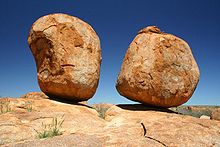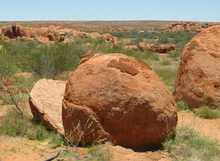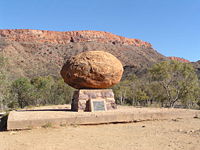
Devil's Marbles Conservation Reserve
Encyclopedia
The Devils Marbles Conservation Reserve is located south of Tennant Creek
area of Northern Territory
in Australia
.
The ‘Devils Marbles’ or ‘Karlu Karlu’ with its gigantic, rounded granite boulders, some spectacularly poised, is a remarkable landscape. Scattered clusters of these ‘marbles’, including many balancing rock
s, are spread across a wide, shallow valley.
The Devils Marbles is a nationally and internationally recognised symbol of Australia’s outback.
In 2007, according to the Northern Territory Natural Resources, Environment, The Arts and Sport 96,172 people visited the reserve. It is one of the most visited of any park or reserve in the Northern Territory and one of the main tourist attractions in the Barkly region.
The Reserve is accessible all year round and has a network of pathways with information boards and a basic camping area. Between May and October each year Rangers offer a program of live events at the site as part of their Territory Parks Alive Program.
Accounts of Aborigines believing the site to be eggs of the mythical Rainbow Serpent are incorrect. In reality many diverse traditional 'Dreaming' stories (none of which are about serpents) intersect at and around Karlu Karlu, hence its great importance as a sacred site. These stories are alive and well and are passed on from generation to generation of Traditional Owners. Only a handful are considered suitable to tell to uninitiated visitors.
On Tuesday 28 October 2008 ownership of Karlu Karlu/Devils Marbles was officially passed from the Parks and Wildlife Service of the Northern Territory back to the Traditional Owners at a ceremony held on the reserve. The reserve is now leased back to the Parks Service under a 99 year lease and the site is now managed by Rangers and Traditional Owners in joint partnership. Visitor access has not been affected.
 The Devils Marbles are made of granite
The Devils Marbles are made of granite
, which surfaces like a little geological island in the desert
, surrounded by large amounts of sandstone
. The granite was formed millions of years ago as a result of the hardening of magma
within the Earth's crust. Thick layers of sandstone on top of it put a lot of pressure on this granite. After the folding of the Earth's crust, which lead to the lifting of the granite and the erosion
of the sandstone, the granite came to the surface. The pressure was gone, letting the granite expand; cracks formed, and it fell apart in big, square blocks.
 The second phase of the formation of the Marbles started when the blocks were exposed to water
The second phase of the formation of the Marbles started when the blocks were exposed to water
. The surface of the blocks began to decay under the influence of the water, and a layer of loose material surrounded the individual blocks. When they came to the surface completely, this layer was flushed away by water and blown away by wind.
The rounding of the granite blocks is a result of both chemical and mechanical weathering. Firstly, exfoliation
plays a part. Chemical processes cause the surface of the blocks to expand and/or shrink. Thin layers of rock come off the boulder. This rounds the granite block, because the chemical processes have more effect on areas with edges. These processes cause the rock to look like it is made of layers like an onion
. In effect, only the outer few centimetres are affected by chemical weathering. This process is called spheroidal weathering
.
Secondly, the boulders are suffering from solarisation. Because the temperature differences between day and night are so great, the rocks expand and shrink a little bit every 24 hours. This causes some rocks to crack, sometimes even splitting them in half.

 One of the marbles was removed from a formation in 1953 and taken to Alice Springs to form a permanent memorial to John Flynn
One of the marbles was removed from a formation in 1953 and taken to Alice Springs to form a permanent memorial to John Flynn
, the founder of the Royal Flying Doctor Service in Australia. At the time, this was seen as a way of remembering his link to the outback
, but in later decades it was a source of great controversy because the rock was removed from a sacred site without the direct permission of the tribal elders. In the late 1990s, a boulder swap was arranged, and the missing marble was removed from the grave, cleaned, and returned to its original place. The grave is now marked with a similar boulder donated by the local Arrernte
people.
Tennant Creek, Northern Territory
Tennant Creek is a town located in the Northern Territory of Australia. It is the fifth largest town in the Northern Territory and it is located on the Stuart Highway, just south of the intersection with the western terminus of the Barkly Highway....
area of Northern Territory
Northern Territory
The Northern Territory is a federal territory of Australia, occupying much of the centre of the mainland continent, as well as the central northern regions...
in Australia
Australia
Australia , officially the Commonwealth of Australia, is a country in the Southern Hemisphere comprising the mainland of the Australian continent, the island of Tasmania, and numerous smaller islands in the Indian and Pacific Oceans. It is the world's sixth-largest country by total area...
.
Location
The area is located near Wauchope, approximately 114 km south of Tennant Creek, in the Northern Territory. The site is known as Karlu Karlu to the land's Aboriginal traditional owners.The ‘Devils Marbles’ or ‘Karlu Karlu’ with its gigantic, rounded granite boulders, some spectacularly poised, is a remarkable landscape. Scattered clusters of these ‘marbles’, including many balancing rock
Balancing rock
A balancing rock, also called balanced rock or precarious boulder, is a naturally occurring geological formation featuring a large rock or boulder, sometimes of substantial size, resting on other rocks, bedrock or on glacial till. Some formations known by this name only appear to be balancing but...
s, are spread across a wide, shallow valley.
The Devils Marbles is a nationally and internationally recognised symbol of Australia’s outback.
In 2007, according to the Northern Territory Natural Resources, Environment, The Arts and Sport 96,172 people visited the reserve. It is one of the most visited of any park or reserve in the Northern Territory and one of the main tourist attractions in the Barkly region.
The Reserve is accessible all year round and has a network of pathways with information boards and a basic camping area. Between May and October each year Rangers offer a program of live events at the site as part of their Territory Parks Alive Program.
Accounts of Aborigines believing the site to be eggs of the mythical Rainbow Serpent are incorrect. In reality many diverse traditional 'Dreaming' stories (none of which are about serpents) intersect at and around Karlu Karlu, hence its great importance as a sacred site. These stories are alive and well and are passed on from generation to generation of Traditional Owners. Only a handful are considered suitable to tell to uninitiated visitors.
On Tuesday 28 October 2008 ownership of Karlu Karlu/Devils Marbles was officially passed from the Parks and Wildlife Service of the Northern Territory back to the Traditional Owners at a ceremony held on the reserve. The reserve is now leased back to the Parks Service under a 99 year lease and the site is now managed by Rangers and Traditional Owners in joint partnership. Visitor access has not been affected.
Formation

Granite
Granite is a common and widely occurring type of intrusive, felsic, igneous rock. Granite usually has a medium- to coarse-grained texture. Occasionally some individual crystals are larger than the groundmass, in which case the texture is known as porphyritic. A granitic rock with a porphyritic...
, which surfaces like a little geological island in the desert
Desert
A desert is a landscape or region that receives an extremely low amount of precipitation, less than enough to support growth of most plants. Most deserts have an average annual precipitation of less than...
, surrounded by large amounts of sandstone
Sandstone
Sandstone is a sedimentary rock composed mainly of sand-sized minerals or rock grains.Most sandstone is composed of quartz and/or feldspar because these are the most common minerals in the Earth's crust. Like sand, sandstone may be any colour, but the most common colours are tan, brown, yellow,...
. The granite was formed millions of years ago as a result of the hardening of magma
Magma
Magma is a mixture of molten rock, volatiles and solids that is found beneath the surface of the Earth, and is expected to exist on other terrestrial planets. Besides molten rock, magma may also contain suspended crystals and dissolved gas and sometimes also gas bubbles. Magma often collects in...
within the Earth's crust. Thick layers of sandstone on top of it put a lot of pressure on this granite. After the folding of the Earth's crust, which lead to the lifting of the granite and the erosion
Erosion
Erosion is when materials are removed from the surface and changed into something else. It only works by hydraulic actions and transport of solids in the natural environment, and leads to the deposition of these materials elsewhere...
of the sandstone, the granite came to the surface. The pressure was gone, letting the granite expand; cracks formed, and it fell apart in big, square blocks.

Water
Water is a chemical substance with the chemical formula H2O. A water molecule contains one oxygen and two hydrogen atoms connected by covalent bonds. Water is a liquid at ambient conditions, but it often co-exists on Earth with its solid state, ice, and gaseous state . Water also exists in a...
. The surface of the blocks began to decay under the influence of the water, and a layer of loose material surrounded the individual blocks. When they came to the surface completely, this layer was flushed away by water and blown away by wind.
The rounding of the granite blocks is a result of both chemical and mechanical weathering. Firstly, exfoliation
Exfoliation
Exfoliation has several meanings:* Exfoliation describes the loss of leaves from a plant.* Exfoliation , is a cosmetic technique aimed at removing dead skin cells from the face and body....
plays a part. Chemical processes cause the surface of the blocks to expand and/or shrink. Thin layers of rock come off the boulder. This rounds the granite block, because the chemical processes have more effect on areas with edges. These processes cause the rock to look like it is made of layers like an onion
Onion
The onion , also known as the bulb onion, common onion and garden onion, is the most widely cultivated species of the genus Allium. The genus Allium also contains a number of other species variously referred to as onions and cultivated for food, such as the Japanese bunching onion The onion...
. In effect, only the outer few centimetres are affected by chemical weathering. This process is called spheroidal weathering
Spheroidal weathering
Spheroidal weathering is a type of chemical weathering that creates rounded boulders and helps to create domed monoliths. This should not be confused with stream abrasion, a physical process which also creates rounded rocks on a much smaller scale...
.
Secondly, the boulders are suffering from solarisation. Because the temperature differences between day and night are so great, the rocks expand and shrink a little bit every 24 hours. This causes some rocks to crack, sometimes even splitting them in half.

Controversy

John Flynn (minister)
John Flynn OBE was an Australian Presbyterian minister who founded the Royal Flying Doctor Service, the world's first air ambulance.-Biography:...
, the founder of the Royal Flying Doctor Service in Australia. At the time, this was seen as a way of remembering his link to the outback
Outback
The Outback is the vast, remote, arid area of Australia, term colloquially can refer to any lands outside the main urban areas. The term "the outback" is generally used to refer to locations that are comparatively more remote than those areas named "the bush".-Overview:The outback is home to a...
, but in later decades it was a source of great controversy because the rock was removed from a sacred site without the direct permission of the tribal elders. In the late 1990s, a boulder swap was arranged, and the missing marble was removed from the grave, cleaned, and returned to its original place. The grave is now marked with a similar boulder donated by the local Arrernte
Arrernte people
The Arrernte people , known in English as the Aranda or Arunta, are those Indigenous Australians who are the original custodians of Arrernte lands in the central area of Australia around Mparntwe or Alice Springs in the Northern Territory. The Arrernte tribe has lived there for more than 20,000 years...
people.

